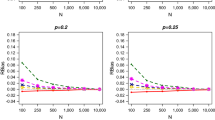Abstract
In the context of capture-recapture modeling for estimating the unknown size of a finite population it is often required a flexible framework for dealing with a behavioural response to trapping. Many alternative settings have been proposed in the literature to account for the variation of capture probability at each occasion depending on the previous capture history. Inference is typically carried out relying on the so-called conditional likelihood approach. We highlight that such approach may, with positive probability, lead to inferential pathologies such as unbounded estimates for the finite size of the population. The occurrence of such likelihood failures is characterized within a very general class of behavioural effect models. It is also pointed out that a fully Bayesian analysis overcomes the likelihood failure phenomenon. The overall improved performance of alternative Bayesian estimators is investigated under different non-informative prior distributions verifying their comparative merits with both simulated and real data.
Similar content being viewed by others
References
Alho JM (1990) Logistic regression in capture-recapture models. Biometrics 46: 623–635
Bartolucci F, Forcina A (2001) Analysis of capture-recapture data with a Rasch-type model allowing for conditional dependence and multidimensionality. Biometrics 57(3): 714–719
Bartolucci F, Forcina A (2006) A class of latent marginal models for capture–recapture data with continuous covariates. J Am Stat Assoc 101(474): 786–794
Bartolucci F, Pennoni F (2007) A class of latent Markov models for capture–recapture data allowing for time, heterogeneity, and behavior effects. Biometrics 63(2): 568–578
Carle FL, Strub MR (1978) A new method for estimating population size from removal data. Biometrics 34(4): 621–630
Chaiyapong Y, Lloyd CJ (1997) Accurate inference for recapture experiments with behavioural response. J Stat Comput Simul 56(2): 97–115
Chao A, Chu W, Hsu CH (2000) Capture–recapture when time and behavioral response affect capture probabilities. Biometrics 56(2): 427–433
Farcomeni A (2011) Recapture Models under Equality Constraints for the Conditional Capture Probabilities. Biometrika, 98(1): 237–242
Fattorini L, Marcheselli M, Monaco A, Pisani C (2007) A critical look at some widely used estimators in mark-resighting experiments. J Anim Ecol 76(5): 957–965
Ghosh SK, Norris JL (2005) Bayesian capture–recapture analysis and model selection allowing for heterogeneity and behavioral effects. J Agric Biol Environ Stat 10(1): 35–49
Huggins RM (1989) On the statistical analysis of capture experiments. Biometrika 76(1): 133–140
Huggins RM (1991) Some practical aspects of a conditional likelihood approach to capture experiments. Biometrics 47(2): 725–732
Hwang WH, Huggins R (2011) A semiparametric model for a functional behavioural response to capture in capture-recapture experiments. Aust NZ J Stat 53(4): 403–421
Hwang WH, Chao A, Yip PSF (2002) Continuous-time capture-recapture models with time variation and behavioural response. Aust NZ J Stat 44(1): 41–54
Lang JB (1996) Maximum likelihood methods for a generalized class of log-linear models. Ann Stat 24(2): 726–752
Lee SM, Chen CWS (1998) Bayesian inference of population size for behavioral response models. Statistica Sinica 8(4): 1233–1248
Lee SM, Hwang WH, Huang LH (2003) Bayes estimation of population size from capture-recapture models with time variation and behavior response. Statistica Sinica 13(2): 477–494
Link WA (2003) Nonidentifiability of population size from capture–recapture data with heterogeneous detection probabilities. Biometrics 59(4): 1123–1130
Mao CX, You N (2009) On comparison of mixture models for closed population capture–recapture studies. Biometrics 65(2): 547–553
Otis DL, Burnham KP, White GC, Anderson DR (1978) Statistical inference from capture data on closed animal populations. Wildlife Monographs,
Ramsey F, Severns P (2010) Persistence models for mark-recapture. Environ Ecol Stat 17(1): 97–109
Rissanen J (1983) A universal prior for integers and estimation by minimum description length. Ann Stat 11(2): 416–431
Sanathanan L (1972) Estimating the size of a multinomial population. Ann Math Stat 43(1): 142–152
Seber GAF, Whale JF (1970) The removal method for two and three samples (Corr: V27 p1104). Biometrics 26(3): 393–400
Stanghellini E, van der Heijden PGM (2004) A multiple-record systems estimation method that takes observed and unobserved heterogeneity into account. Biometrics 60(2): 510–516
Tardella L (2002) A new Bayesian method for nonparametric capture-recapture models in presence of heterogeneity. Biometrika 89(4): 807–817
Yang HC, Chao A (2005) Modeling animals’ behavioral response by Markov chain models for capture-recapture experiments. Biometrics 61(4): 1010–1017
Yip PSF, Xi L, Chao A, Hwang WH (2000) Estimating the population size with a behavioral response in capture-recapture experiment. Environ Ecol Stat 7(4): 405–414
Zeng L, Cook RJ (2007) Transition models for multivariate longitudinal binary data. J Am Stat Assoc 102(477): 211–223
Author information
Authors and Affiliations
Corresponding author
Rights and permissions
About this article
Cite this article
Fegatelli, D.A., Tardella, L. Improved inference on capture recapture models with behavioural effects. Stat Methods Appl 22, 45–66 (2013). https://doi.org/10.1007/s10260-012-0221-4
Accepted:
Published:
Issue Date:
DOI: https://doi.org/10.1007/s10260-012-0221-4




